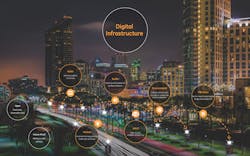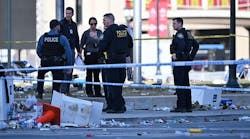According to a report released by the UN in 2018, more than half of the world’s population lives in an urban area or city. This number is expected to rise to almost 70 percent in the next 30 years. While people move to cities for a variety of reasons, we all have one expectation in common: that we will be safe.
The smart city movement is leading citizens to expect more from their urban environments. We want our growing cities to provide us with better access, greater energy efficiency, and more convenience than ever before. At the same time, we need our cities to be able to ensure the safety of their citizens. Fortunately, today’s technology can do all of this while also laying the groundwork for future advancements.
What is the Relationship Between Smart and Safe in Cities?
In many ways, the smart city movement is providing the infrastructure necessary to increase public safety. That said, smart city initiatives don’t always start with public safety in mind. Many cities focus on addressing municipal challenges in areas like lighting, traffic, and parking. Even so, what cities are discovering is that the infrastructure being built to help make them more efficient can also be used to safeguard their citizens.
In 2016, the City of San Diego invested in smart streetlight technology and installed brighter, more cost-effective LED lights in its neighborhoods. Initially, the city used the sensor data collected by the lighting system to inform municipal decisions around traffic flow and pedestrian crossings. And then they discovered that the technology could also be used to help maintain public safety.
According to Lt. Jeffrey Jordan, Chief’s Office/Special Projects of the San Diego Police Department, “We use technology as a means of enhancing investigations, preventing crime, and interacting with community members to ensure their safety.”
Today, San Diego is using smart streetlight technology in conjunction with their video management system (VMS) to positively impact the lives of its citizens. “We have only 1800 officers for a city of 1.3 million people spread out over 300 square miles. We can’t be everywhere all the time. But we can use the data being collected by the smart streetlights to help provide evidence for violent crime investigations and fatal or near-fatal car collisions,” explained Lt. Jordan.
Lt. Jordan asserts that smart cities are safe cities because they enable police departments and law enforcement the world over to leverage technology to enhance their commitment to protecting lives and property. Their city is already seeing results.
Making a Difference with Smart Technology in San Diego
Since the summer of 2018, San Diego has used the data collected via the sensors in their smart streetlights on approximately one hundred investigations. In more than 60 percent of those cases, officers found the information gathered to be either helpful, in that it saved time or improved efficiency, or critical, in that it meant identifying a suspect and significantly altering their understanding of a case.
What is becoming clear is that public safety must be a pillar of any smart city strategy from the very beginning. In addition to looking at lighting and traffic flow, municipal governments must also ensure that issues surrounding public safety are included in the decision-making process around smart city implementation.
According to Sam Klepper, Senior Vice President Marketing and Product Strategy at ShotSpotter, “Research has shown that, from city officials to community members, of the top issues for smart cities, public safety is number one.” Ultimately, even in the most technologically advanced city in the world, if citizens don’t feel safe, businesses can’t succeed and the city will not thrive.
The question is, where do you start? The answer is local government.
The Role of Municipal Governments in Smart Cities
The essence of a smart city is the ability to communicate and collaborate at a much higher level. The main driver in this is municipal governments. They are the ones with the vision and budget necessary to bring together the disparate groups involved.
The role of municipal governments can be divided into three main parts. First, they have to work toward breaking down the silos between their departments and other stakeholders. Second, they have to work as the liaison with both the private sector and citizens to ensure that both groups are included. And, third, they have to select the smart city technology that is right for their particular needs.
City Interests are Business Interests
To make a smart city work, businesses in the urban environment are going to have to expand their thinking about public safety and the role they play in maintaining it. Where once private enterprises might have seen safety as falling outside of their business interests, today they must recognize that public safety is vital to their success.
Any organization that has a piece of a city, be it storefront, parking lot, or corporate campus, should recognize that their interests overlap with the city’s mandate to ensure that people can live, work, and play without fear or worry. When people feel safe, they access services more easily and spend money more freely. This increases opportunity for everyone.
If every business worked in collaboration with local police departments, they would be able to create more powerful solutions that would provide greater resources and be more sustainable. Of course, this is not without its own set of challenges. “There have always been reasons not to connect things—especially from an internet security or IT perspective,” explained Christian Connors, CEO of Shooter Detection Systems.
But, with advances in cybersecurity and system integration, there’s been a shift in who is joining the conversation. “Now that we have shown that there are reasons to connect private systems to public infrastructure, we’re seeing different stakeholders come to the table. It’s not just an IT person or a facilities manager, not even just general security. We’re getting to a higher level of decision-maker. They all want to have a say in what their smart, safe city will look like,” said Connors.
Facilitating Collaboration
Connecting the public and private sectors is so important to the process of developing a smart city that the team at Shooter Detection Systems has found itself working to bridge the two. While their core business is to provide gunshot detection solutions to government agencies, Fortune 1000 companies, air and sea ports, utilities, K-12 schools, colleges, and universities, Shooter Detection Systems is increasingly in the position of bringing people together.
Part of their deployment strategy has been facilitating relationships. “We have had to go create public-private partnerships in cities across the country with police departments and city halls to be able to integrate both private and public buildings into a smart city,” said Connors.
One particularly challenging area arises when integrating a school’s system with a city’s infrastructure. It is not surprising that schools are concerned that they will violate privacy regulations if they open connections with local law enforcement. To address this, Shooter Detection Systems develops solutions that use only push notifications. If an event occurs, the school’s system sends data, including video surveillance, directly to law enforcement. This one-way connection can provide critical situational intelligence in real-time while also safeguarding privacy.
Schools are not alone when it comes to the need to protect personal privacy. Both public and private organizations must select solutions that allow them to protect all personal data collected by their systems. For example, choosing a video surveillance solution that encrypts both in-transit and archived video and also protects data through user authentication and video authorization is vital for protecting everyone’s privacy.
Through technology and relationship facilitation, solutions providers are in a position to help integrate stakeholders within a smart city to dramatically improve public safety.
Get Local Communities Involved
Another key component in building a successful smart city is community involvement. “One of the mistakes that some cities have made is unilaterally deciding to bring in smart city technology without working with the community. We have to make citizens active participants in deciding what is brought in and how. When you work the other way around and inform the community after the fact, you risk backlash and non-engagement. This can be a real obstacle to full deployment and acceptance,” explained Klepper.
At ShotSpotter, they address this by working with local law enforcement agencies to hold community meetings in advance of deploying the technology. “We want to educate community members on how the product works and what it’s going to do for them,” said Klepper.
ShotSpotter provides an advanced system of sensors, algorithms, and artificial intelligence that detects and locates gunfire and then alerts police. For them, it’s important to reassure citizens that there is minimal risk of audio surveillance. As Klepper explained, “While there are microphones in our products, they are calibrated for loud pulse sounds, like gunfire. It is almost impossible for the sensors to be triggered by human conversation based on the way the technology is designed.”
Cities that have adopted ShotSpotter systems have seen a decrease in gunshot incidents and improvements in relations between law enforcement and the community. According to Klepper, 80 percent of gunshot incidents on average in the US are not reported to police via 911. If law enforcement is unaware of incidents, they cannot respond.
With ShotSpotter systems, police can identify and respond to virtually all gunshots within a coverage area. By responding to all gunshot incidents, the police can demonstrate their commitment to the community. Community members, in turn, believe that they are being supported and are more likely to co-operate with police to help find the small number of shooters who are responsible for most crime. As shooters are identified, they can be jailed, rehabilitated, or reeducated. This results in a decrease in gun violence.
Policies That Reflect Core Values
Developing a successful smart city also requires addressing community concerns. When law enforcement in San Diego began using data collected by the city’s smart streetlight technology, officials spent time doing due diligence to understand where issues might arise.
By engaging the community, the officials found that citizens had a short list of concerns. These included automatic tracking, facial recognition, and data storage—or how long the city would maintain video footage.
As a result of their findings, local law enforcement drafted policies stating that the systems will not track individuals automatically, that the city will not deploy facial recognition technology, and that the department will store video data for only 5 days.
Lt. Jordan explained, “You can leverage technology as a force multiplier to safeguard citizens through the investigation and prevention of crime. But you also have to have the policies behind that technology that support the core values of your city. At the end of the day, law enforcement officers and elected officials serve the community.”
As the City of San Diego found, one of the overriding concerns that community members everywhere have centers on personal privacy. Here again, selecting the right technology, designed to meet the wide variety of specific challenges a city or organization might face, can help alleviate their concerns.
Building an Eco-System of Systems for the Future
Serving communities can become more efficient as our smart cities develop and grow. The ability to collect and understand ever-increasing amounts of data will improve how cities provide services and protect their citizens in the future.
One particularly interesting area will be system integration. Based on the Internet of Things (IoT) and the smart city movement, we’re already starting to see an exponential increase in the number of data points we collect. Cities can use this data for an incredibly wide variety of purposes, including traffic, parking, and public safety.
But, as we move forward, we’ll be integrating systems rather than devices, giving rise to increased access to even more data. Ultimately, cities, in collaboration with the private sector and technology providers, will be creating ecosystems of systems. This unification will have an even greater impact on public safety.
In the future, when an event occurs, harnessing a city’s system of systems will exponentially improve situational awareness. It will also have a similar impact on the time required to collect the appropriate information and perform an investigation. The challenge for solutions providers will be to create technology that presents all this data in a human-readable way.
We’re confident that, through collaborative efforts between citizens, city governments, private businesses, and technology providers, we can start building smart, safe cities today that will continue to meet the needs of their ever-increasing populations in the future.
About the author: Bob Carter is the Business Development Manager for Smarter and Safer Cities for Genetec Inc. This practice is dedicated to working with our nation’s growing population centers to address public safety, security and operational challenges using Genetec’s Strategic Decision Support System - Citigraf - and a portfolio of government, law enforcement, traffic, transit, campus and digital evidence management solutions.


